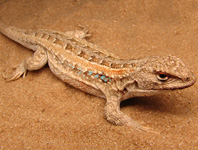Abstract
Three species of Micaria Westring, 1851 are known to occur in the Afrotropical Region, two from Namibia and one from South Africa. All three species are known from a single sex only, either from the male (M. tersissima Simon, 1910) or from the females in the case of M. beaufortia (Tucker, 1923) and M. chrysis (Simon, 1910). In this paper, we redescribe the female of M. beaufortia and describe the previously unknown male of this species. This species has pseudosegmented tarsi and complex scopula formed by two paired rows of setae; these characters are unknown in other Micaria. The setae covering the legs in M. beaufortia are briefly described and the scopula is compared with that of M. fulgens (Walckenaer, 1802). A paired mating plug, previously unknown in Micaria, is documented in M. beaufortia. It was found that M. chrysis and M. tersissima, considered in the World Spider Catalog (2017) as endemics of Namibia, were actually described from Northern Cape Province, South Africa. The taxonomic position of these two species is briefly commented on and distribution records of all three species are mapped.
References
Bosmans, R. & Blick, T. (2000) Contribution to the knowledge of the genus Micaria in the West-palaearctic region, with description of the new genus Arboricaria and three new species (Araneae Gnaphosidae). Memorie della Società Entomologica Italiana, Genova, 78, 443‒476.
Lucas, H. (1846) Histoire naturelle des animaux articules. In: Exploration scientifique de l'Algerie pendant les annees 1840, 1841, 1842 publiee par ordre du Gouvernement et avec le concours d'une commission academique. Zoologie 1. Sciences physiques, Paris, 183 pp. [pp. 89‒271]
Marusik Y.M., Omelko M.M. & Koponen, S. (2013) Redescription of Pterotricha loeffleri (Roewer, 1955) (Aranei: Gnaphosidae: Gnaphosinae). Arthropoda Selecta, 22 (4), 349‒352.
Mikhailov, K.G. & Marusik, Y.M. (1996) Spiders of the north-east of the USSR. Families Clubionidae, Zoridae, Liocranidae and Gnaphosidae (genus Micaria) (Arachnida, Aranei). In: Entomological Studies in the North-East of the USSR. USSR Academy of Sciences, Institute of Biological Problems of the North, Vladivostok, pp. 90‒113.
Murphy, J. (2007) Gnaphosid genera of the world. Vol. 1. & 2. British Arachnological Society, St Neots, Cambridgeshire, 605 pp. [Vol. 1: pp. i–xii + 1–92, Vol. 2: pp. i‒ii, 93‒605]
Platnick, N.I. (2014) The world spider catalog. Version 15. American Museum of Natural History. Available from: http://research.amnh.org/entomology/spiders/catalog/index.html (accessed 28 March 2017)
Ramírez, M. (2014) The morphology and phylogeny of dionychan spiders (Araneae: Araneomorphae). Bulletin of the American Museum of Natural History, 390, 1‒374.
https://doi.org/10.1206/821.1Roewer, C.F. (1955) Katalog der Araneae von 1758 bis 1940, bzw. 1954. Vol. 2. Institut royal des sciences naturelles de Belgique, Bruxelles, 1751 pp.
Simon, E. (1910) Arachnoidea. Araneae (ii). In: Schultze, L. (Ed.), Zoologische und anthropologische Ergebnisse einer Forschungsreise im Westlichen und zentralen Südafrika. Denkschriften der Medizinisch-Naturwissenschaftlichen Gesellschaft zu Jena, 1910, pp. 175‒218.
Tucker, R.W.E. (1923) The Drassidae of South Africa. Annals of the South African Museum, 19, 251‒437.
World Spider Catalog (2017) World Spider Catalog. Natural History Museum Bern, version 18.0. Available from: http:// wsc.nmbe.ch (accessed 28 March 2017)
Wunderlich, J. (1980) Revision der europäischen Arten der Gattung Micaria Westring 1851, mit Anmerkungen zu den übrigen paläarktischen Arten (Arachnida: Araneida: Gnaphosidae). Zoologische Beiträge, 25 (1979), 233‒341.

